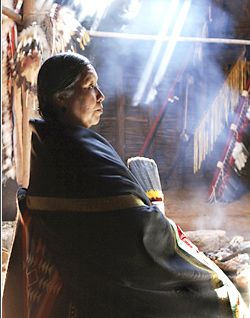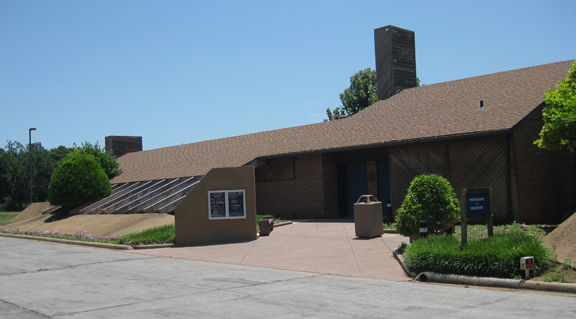|
Kiowa Apache
The Plains Apache are a small Southern Athabaskan tribe who live on the Southern Plains of North America, in close association with the linguistically unrelated Kiowa Tribe. Today, they are headquartered in Southwestern Oklahoma and are federally recognized as the Apache Tribe of Oklahoma. They mostly live in Comanche and Caddo County, Oklahoma. Name Their autonym is Ná'ishą, or "takers" based on their skill at stealing horses, or Naishadena, meaning "our people." This is also written ''Na-i-shan Dine''.Pritzker, 295 They were also called ''Káłt'inde'' or ''γát dìndé'' meaning "cedar people" or ''Bek'áhe'' meaning "whetstone people". The Plains Apache are also known as the Kiowa Apache. To their Kiowa allies, who speak an unrelated language, the Plains Apache are known as Semat. At major historical tribal events, the Plains Apache formed part of the Kiowa tribal "hoop" (ring of tipis). This may explain why the Kiowa named the Plains Apache ''Taugui'' meaning "sitting ou ... [...More Info...] [...Related Items...] OR: [Wikipedia] [Google] [Baidu] |
Plains Apache Language
The Plains Apache language is a Southern Athabaskan language formerly spoken by the Plains Apache, organized as the Apache Tribe of Oklahoma, living primarily around Anadarko in southwest Oklahoma. The language is extinct as of 2008, when Alfred Chalepah, Jr., the last native speaker, died.Morgan, J. L. (2012). ''Classificatory Verbs in Plains Apache'' (Doctoral dissertation, University of Oklahoma). Plains Apache is the most divergent member of the Southern Athabaskan languages, a family which also includes Navajo, Chiricahua Apache, Mescalero Apache, Lipan Apache, Western Apache, and Jicarilla Apache. As a member of the broader Athabaskan family, it has an extremely complex system of verbal morphology, often enabling entire sentences to be constructed with only a verb. Phonology This article follows the orthography of Bittle (1963); where this differs from the IPA, IPA is given between slashes. Consonants Plains Apache has a large consonant inventory resembling that ... [...More Info...] [...Related Items...] OR: [Wikipedia] [Google] [Baidu] |
Kiowa Tribe
Kiowa ( ) or Cáuigú () people are a Native Americans in the United States, Native American tribe and an Indigenous people of the Great Plains of the United States. They migrated southward from western Montana into the Rocky Mountains in Colorado in the 17th and 18th centuriesPritzker 326 and eventually into the Southern Plains by the early 19th century. In 1867, the Kiowa were moved to a Indian reservation, reservation in Southwestern Oklahoma. Today, they are Federally recognized tribe, federally recognized as Kiowa Indian Tribe of Oklahoma with headquarters in Carnegie, Oklahoma. , there were 12,000 citizens. The Kiowa language, Kiowa language (Cáuijògà), part of the Tanoan languages, Tanoan language family, is in danger of extinction, with only 20 speakers as of 2012."Kiowa Tanoan" ''Ethnologue.'' Retrieved 21 June 2012. ... [...More Info...] [...Related Items...] OR: [Wikipedia] [Google] [Baidu] |
Blood Quantum Laws
Blood quantum laws or Indian blood laws are laws that define Native Americans in the United States status by fractions of Native American ancestry. These laws were enacted by the federal government and state governments as a way to establish legally defined racial population groups. By contrast, many tribes do not include blood quantum as part of their own enrollment criteria. Blood quantum laws were first imposed by white settlers in the 18th century. Blood quantum (BQ) continues to be a controversial topic. History of blood quantum law In 1705, the Colony of Virginia adopted the "Indian Blood law" that limited the civil rights of Native Americans and persons of one-half or more Native American ancestry. This also had the effect of regulating who would be classified as Native American. In the 19th and 20th centuries, the US government believed tribal members had to be defined for the purposes of federal benefits or annuities paid under treaties resulting from land cessions ... [...More Info...] [...Related Items...] OR: [Wikipedia] [Google] [Baidu] |
Harmon County, Oklahoma
Harmon County is a county in the southwest corner of the U.S. state of Oklahoma. As of the 2020 Census, the population was 2,488, making it the second-least populous county in Oklahoma, behind only Cimarron County. It has lost population in every census since 1930. The county seat is Hollis. History Following an election on May 22, 1909, Harmon County was created by proclamation of Governor Lee Cruce on June 2. Carved from adjacent Greer County, the new county was named in honor of Judson Harmon, who was Governor of Ohio at the time. The area now covered by Harmon County had been a part of Greer County, Texas until the U. S. Supreme Court awarded it to Oklahoma Territory in 1896.Wilson, Linda D"Harmon County,"''Encyclopedia of Oklahoma History and Culture'', Oklahoma Historical Society, 2009. Accessed April 4, 2015. Another election held September 1, 1909, confirmed Hollis as the county seat. There were two other contestants: the towns of Harmon and Rosser. County offic ... [...More Info...] [...Related Items...] OR: [Wikipedia] [Google] [Baidu] |
Tillman County, Oklahoma
Tillman County is a county located in the southwestern part of Oklahoma, United States. As of the 2020 census, the population was 6,968. The county seat is Frederick. History The Medicine Lodge Treaty of 1867 established a reservation in the southwestern part of Indian Territory for the Kiowa, Apache and Comanche tribes. The Jerome Commission started enrolling members of these tribes in 1892, a prerequisite to opening "excess" land for settlement by non-Indians. The first lottery was held on August 6, 1901. It was followed in 1906 by the "Big Pasture" Lottery.Wilson, Linda D"Tillman County,"''Encyclopedia of Oklahoma History and Culture'', Oklahoma Historical Society, 2009. Accessed April 5, 2015. The county was founded at the time of Oklahoma statehood in 1907, and was named for Senator Benjamin Tillman of South Carolina. It had previously been part of Comanche County, Oklahoma Territory. Frederick was designated as the county seat at the time of statehood. In 1910 and 1 ... [...More Info...] [...Related Items...] OR: [Wikipedia] [Google] [Baidu] |
Kiowa County, Oklahoma
Kiowa County is a county located in the southwestern part of the U.S. state of Oklahoma. As of the 2020 census, its population was 8,509. Its county seat is Hobart. The county was created in 1901 as part of Oklahoma Territory. It was named for the Kiowa people. History In 1892, the Jerome Commission began enrolling the Kiowas, Comanches, and Apaches to prepare for the opening of their reservation to settlement by Whites. Dennis Flynn, the territorial representative to the U. S. Congress, proposed holding a lottery for opening the reservation. He argued successfully that the lottery would be safer and more orderly than land runs used earlier. Individuals could register at offices in Lawton or El Reno; 165,000 individuals registered for 13,000 160-acre claims. The drawing was held August 6, 1901. After the opening, the area was designated as Kiowa County in Oklahoma Territory. The town of Hobart, named for Vice President Garrett A. Hobart, was designated as county seat.Cole, ... [...More Info...] [...Related Items...] OR: [Wikipedia] [Google] [Baidu] |
Jackson County, Oklahoma
Jackson County is a county located in the southwestern corner of the U.S. state of Oklahoma. As of the 2020 census, the population was 24,785. Its county seat is Altus. According to the ''Encyclopedia of Oklahoma History and Culture'', the county was named for two historical figures: President Andrew Jackson and Confederate General Stonewall Jackson.Wilson, Linda D"Jackson County,"''Encyclopedia of Oklahoma History and Culture'', Oklahoma Historical Society, 2009. Accessed April 4, 2015. One source states that the county was named only for the former president, while an earlier source states it was named only for General Stonewall Jackson. Jackson County comprises the Altus, OK micropolitan statistical area. History After a dispute over the Adams-Onís Treaty of 1819, both the governments of the United States and the state of Texas claimed ownership of some in what was then operated as Greer County, Texas. Litigation followed, and in the case of ''United States v. State o ... [...More Info...] [...Related Items...] OR: [Wikipedia] [Google] [Baidu] |
Greer County, Oklahoma
Greer County is a county located along the southwest border of the U.S. state of Oklahoma. As of the 2020 census, the population was 5,491. Its county seat is Mangum. From 1860 to 1896, the state of Texas claimed an area known as Greer County, Texas, which included present-day Greer County along with neighboring areas. In 1896 it was designated as a county in Oklahoma Territory under a ruling by the US Supreme Court. The rural Greer County is home to Quartz Mountain State Park, near the community of Lone Wolf, Oklahoma. It is also home to the Oklahoma State Reformatory, located in Granite. Its population has declined since 1930 due to changes in agriculture and migration to cities for work. History After a dispute over the 1819 Adams-Onís Treaty and the related 1828 Treaty of Limits, the governments of both the United States and the state of Texas claimed ownership of some in what was then operated as Greer County, Texas. The county was named for former Texas lieut ... [...More Info...] [...Related Items...] OR: [Wikipedia] [Google] [Baidu] |
Cotton County, Oklahoma
Cotton County is a County (United States), county located in the U.S. state of Oklahoma. As of the 2020 United States census, 2020 census, the population was 5,527. Its county seat is Walters, Oklahoma, Walters. When Oklahoma achieved statehood in 1907, the area which is now Cotton County fell within the boundaries of Comanche County, Oklahoma, Comanche County. It was split off in 1912, becoming the last county created in Oklahoma; it was named for the county's primary crop.O'Dell, Larry,Cotton County" ''Encyclopedia of Oklahoma History and Culture'', 2009, Accessed March 28, 2015. Cotton County is included in the Lawton, Oklahoma metropolitan area. History The eastern part of what is now Cotton County was opened to settlement by non-Native Americans by the 1901 Kiowa-Comanche-Apache Opening, which distributed land by a lottery system. In 1906, the remainder of the present county, then known as the Big Pasture was opened through a sealed bid process. Most of this territory beca ... [...More Info...] [...Related Items...] OR: [Wikipedia] [Google] [Baidu] |
Anadarko, Oklahoma
Anadarko is a city in and the county seat of Caddo County, Oklahoma, United States. The city is 50 miles (80.5 km) southwest of Oklahoma City. The population was 5,745 at the 2020 census. History Anadarko got its name when its post office was established in 1873. The designation came from the Nadaco Native Americans, a branch of the Caddo Nation, and the "A" was added due to a clerical error.Carolyn Riffel and Betty Bell, "Anadarko." ''Encyclopedia of Oklahoma History and Culture''. Accessed April 17, 2015. In 1871, the Wichita Agency was reestablished on the north bank of the Washita River after being destroyed in the |
Tipi
A tipi or tepee ( ) is a conical lodge tent that is distinguished from other conical tents by the smoke flaps at the top of the structure, and historically made of animal hides or pelts or, in more recent generations, of canvas stretched on a framework of wooden poles. The loanword came into English usage from the Dakota and Lakota languages. Historically, the tipi has been used by certain Indigenous peoples of the Plains in the Great Plains and Canadian Prairies of North America, notably the seven tribes of the Sioux, as well as among the Iowa people, the Otoe and Pawnee, and among the Blackfeet, Crow, Assiniboines, Arapaho, and Plains Cree. Lewis H. Morgan, "I have seen it in use among seven or eight Dakota sub-tribes, among the Iowas, Otoes, and Pawnees, and among the Black-feet, Crows, Assiniboines, and Crees. In 1878, I saw it in use among the Utes of Colorado. A collection of fifty of these tents, which would accommodate five hundred persons, make a picturesqu ... [...More Info...] [...Related Items...] OR: [Wikipedia] [Google] [Baidu] |



